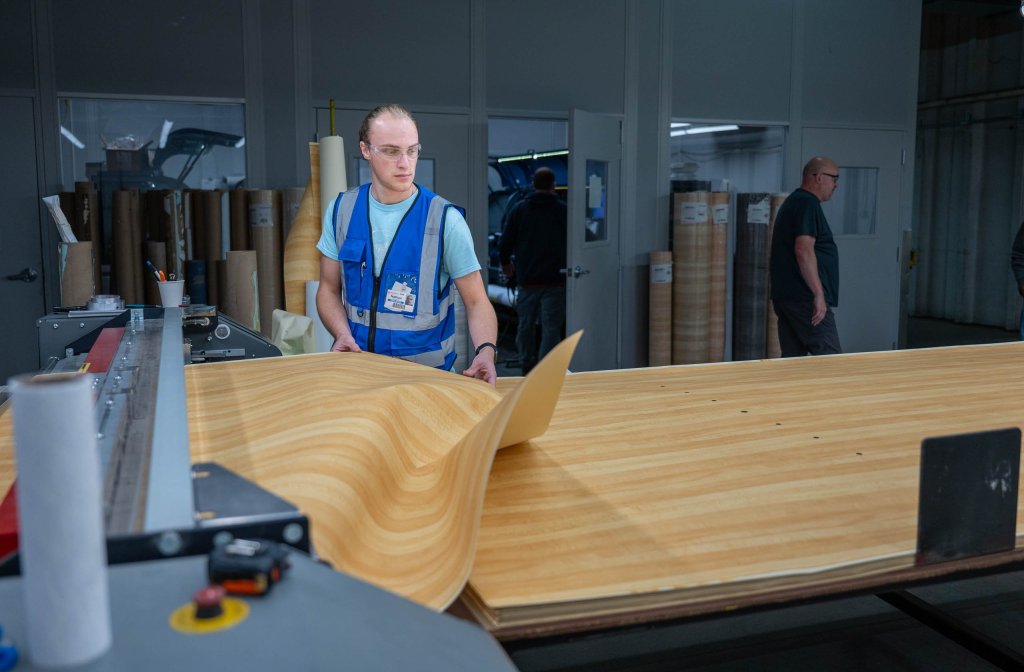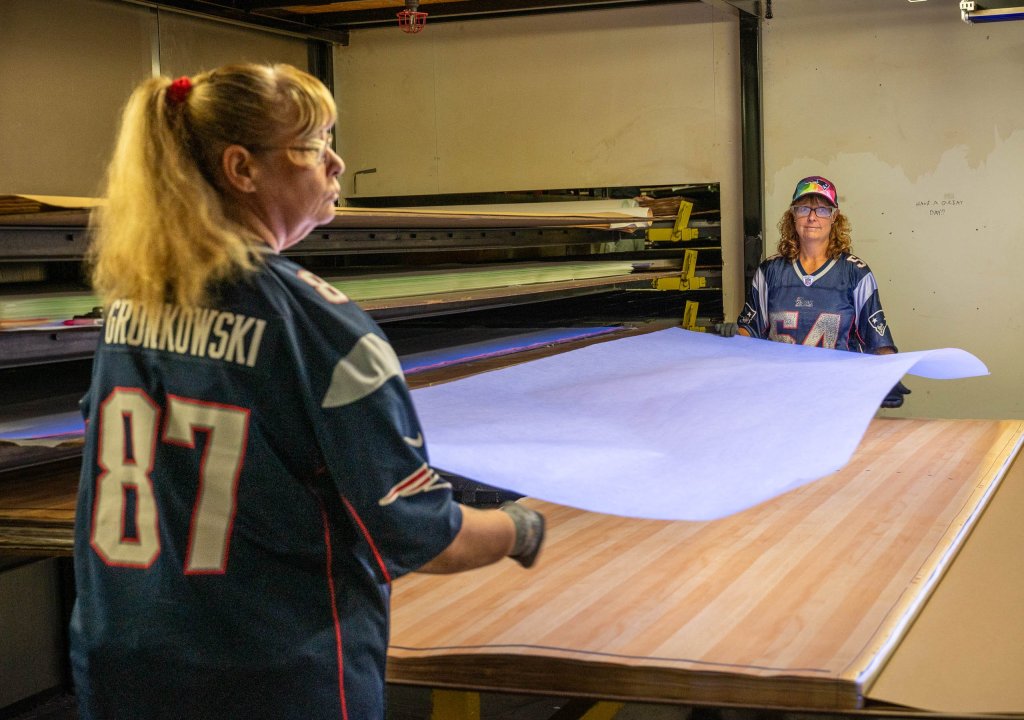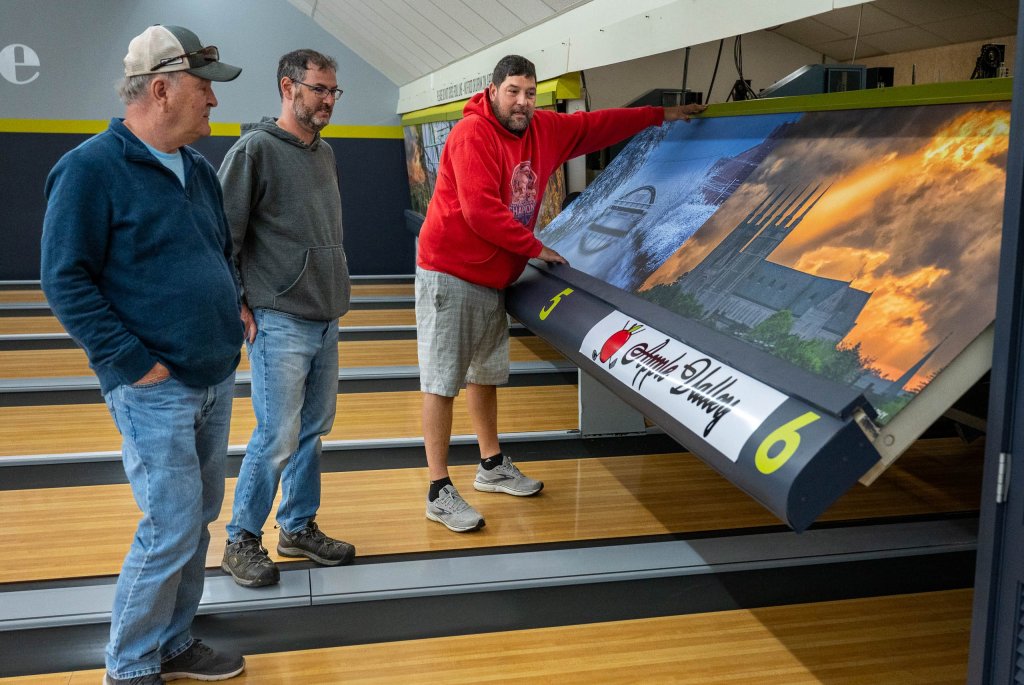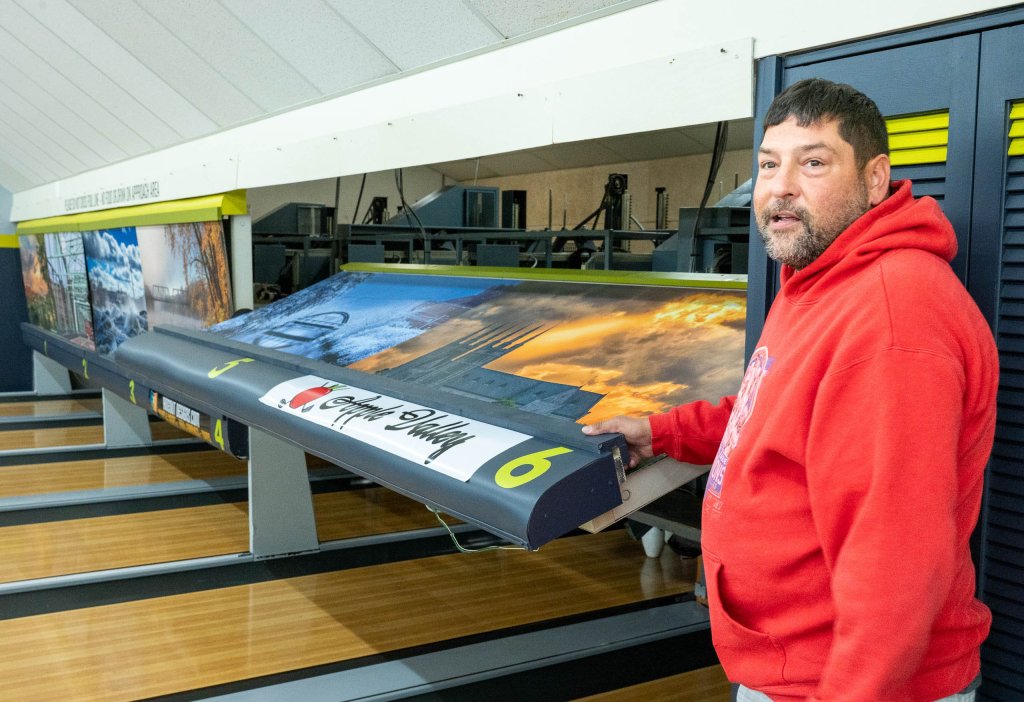LEWISTON — Inside Just-In-Time Recreation on Mollison Way, 16 very special photos adorn the walls above the bowling lanes that have become part of the healing process for some in the wake of the Oct. 25, 2023, mass shooting.
In the weeks and months following the tragedy, people were searching for answers and relief. Many people in Lewiston and Auburn also searched for ways to help one another and the victims of a very dark chapter in the city’s history.
Brad Tripp is the materials and community relations manager at Panolam Surface Systems, or Pioneer Plastics as most people still know it. One of the products they make at Panolam is bowling panels — layers of thin paper laminated on top of each other in 12-foot sections that form bowling lanes.
Tripp went to school with Justin Juray, the co-owner of Just-In-Time Recreation, and their sons played baseball together. The bowling alley is one of two locations where gunfire erupted during a youth bowling league night — leaving seven people dead and many others wounded. One of the wounded died later at Central Maine Medical Center.

Justin Juray, co-owner of Just-In-Time Recreation, demonstrates how the panels covering the end of the lanes tilt up for access to the machinery. Each panel is now adorned with photography from 16 Lewiston landmarks, captured by local photographers Richard Plourde and Ram Sports Photography. Richard Plourde, left, and Panolam Materials Manager Brad Tripp look on. Andree Kehn/Sun Journal
Within a few weeks, Tripp said he reached out to Juray to offer help as he looked to reopen the venue. “We make bowling lanes here and we want to help you guys in some way,” he remembers asking. “Is there something we can do for you guys?”
It turns out they didn’t need any bowling panels as they had acquired them already. But they did need something else. Masking panels at the end of each lane to hide the pinsetters and ball return machines from public view.
All the panels were old and one had two bullet holes, which Juray said “had to go.”
“Why don’t you come over and do a tour and check out how things are made?” Juray recalls from an early conversation with Tripp. A few months later he went on a plant tour of Panolam. “I saw those murals that he had up and I asked him, I said, ‘Can you turn those sideways’? He said ‘Absolutely,’ and that’s how this was born.”

Photo panels depicting Lewiston scenes were printed at Panolam Surface Systems in Auburn for Just-In-Time Recreation in Lewiston. Andree Kehn/Sun Journal
HOW THE 16 PHOTO PANELS CAME TOGETHER
The murals Juray referred to were hanging vertically on the walls inside the Panolam plant. It’s another product they make — photos or artwork laminated into large panels that hang in hospitals, office buildings, schools and other commercial buildings.
Juray’s mind started spinning. As he toured the Panolam plant, he saw how the process comes together. A lot of what they do at Panolam is based on the lamination process. Sheet after sheet of razor-thin paper treated with resin is layered, then compressed and heated so they laminate, with a protective coating on top.

Michelle Mabry, left, and April Whitten layer glow-in-the-dark sheets and wood-designed sheets for creating panels for bowling lanes on Oct. 4 at Panolam Surface Systems in Auburn. Andree Kehn/Sun Journal
Scott Cronkhite is a digital production artist at Panolam. He started working with Juray, who wanted to provide the photos to be reproduced. “They supplied us with the photos and once we saw the quality of the original photos…”
Cronkhite explained that they needed to be very high resolution, and photos from most phones wouldn’t work.
“I just wanted Lewiston,” Juray said. “Just things that everybody would know. And if anybody that has been in this town at all looks at any of these pictures, they know where they are.”
Cronkhite had an idea. “I reached out to my boss and asked if I could reach out to photographers that I had seen and from around town and ask them if they would donate.”
Richard Plourde is a local photographer whose images not only fit the bill, but they also feature some of the most recognizable scenes in Lewiston and have been shared all over social media.
“I was really kind of honored because it’s nothing that I really was expecting, you know,” Plourde explained during a recent visit to Just-In-Time Recreation. “I thought about trying to find a way to donate or do something and then all of a sudden it comes to me,” he said.
Cronkhite also reached out to Ram Photography, which provided four of the 16 photos ultimately chosen to cover the lanes. The entire project was organic, in the sense there was no formal process as it’s not the type of project Panolam normally does. Other members of the digital team gave their input on placement and grouping of the photos.
“Justin was kept in the loop the entire time,” Cronkhite said, “like, once I got a panel situated, we let him approve.”

Panolam employees got to see a preview of the 16 photo panels made for Just-In-Time Recreation before they were donated and mounted inside the bowling alley. Submitted photo
When the panels were ready, the management team at Panolam put them on display for employees to see and understand what they were doing and why.
“To have some sense of pride in what they were, what their labor went into,” offered Tripp. While not everyone had a hand in producing them, the next time they go to Just-In-Time they can say that they work at the place that made the panels.
John Eberly, Panolam’s operations manager, said the employees were ecstatic. “Given the circumstances, people certainly were still dwelling over the event and really trying to internalize that, and some were having more difficulty than others,” he added. “But beyond that, it was a positive in a negative environment of the time. It was a positive.”
By April 18, the panels were delivered just two weeks before the reopening of Just-In-Time Recreation and there was no time to waste. Cronkhite and Tripp delivered the photo panels and recall how Juray and his employees were excited to see them and wanted them installed right away.
FAMILIARITY CAN HELP THE HEALING PROCESS
Studies show that familiarity is a positive, and that people prefer things they are familiar with. It’s kind of like a security blanket. That might help explain why Juray wanted images of Lewiston on the walls of his business.
He chose the 16 images from a pool of 24 and he says customers have been nothing but positive about the photos. “They love them,” he said with a smile, “everybody makes a comment about them.” For Juray, it wasn’t hard to choose. “If you can find one of the hot air balloon launches — everybody knows that REMAX balloon.”
There’s the “Hopeful” sign by Lewiston native and Portland artist Charlie Hewett that’s known across Maine and beyond. Great Falls and the canals scream Lewiston, too. Juray says even the graffiti on the old Cowan Mill is familiar. “It’s part of Lewiston,” he said.
Juray has two favorite images that dress up the walls at Just-In-Time — lane 6 and lane 8. The first is the Basilica of Saints Peter and Paul with an almost divine play of sunlight in the backdrop. The other is what photographer Richard Plourde describes as “a colorful late afternoon rainbow over the heart of the city of Lewiston.”
For Juray, it has an extra meaning attached to it. “I don’t know if anybody remembers, but I think it was maybe a week, two weeks after the shooting, it was pretty quick after the shooting … somebody took pictures of rainbows coming right down on this building. It was awesome … We were all going through a lot, but it let us know there was still hope.”
That somebody was Shari Cloutier, whose office is on Mollison Way, overlooking Just-In-Time Recreation. She recently took another similar photo with a double rainbow in almost the exact same position.
“This is Lewiston. We came together as a community,” Juray commented. “Everybody has been so supportive, and you know we all lost a lot … everybody you talk to knows somebody who was affected one way or another.”
Panolam has been a part of the local community for more than 50 years and the leadership team feels it was important to be involved in the project.
“We’ve always taken the position that we want to be tied and connected to the community that we’re a big part of,” Eberly said. “This was just another opportunity to do that.”
“For a little bit of time and effort for us to do something like this, you know, I feel it just helps,” offered Tripp. “We helped Justin, but also, you know, it helps some of our employees.”
“There is not a single person in this plant who is not connected to one of the victims … I mean in some way,” Eberly added.
Juray said the business keeps him busy and he has seen an increase over last year in the number of bowlers in the youth league from 30 to 51. “Those kids are resilient, and it’s grown … they fill the house now,” he said. “The youth program is obviously my future, but it shows me that they want to be here … they’re OK being here.”
Send questions/comments to the editors.










We invite you to add your comments. We encourage a thoughtful exchange of ideas and information on this website. By joining the conversation, you are agreeing to our commenting policy and terms of use. More information is found on our FAQs. You can modify your screen name here.
Comments are managed by our staff during regular business hours Monday through Friday as well as limited hours on Saturday and Sunday. Comments held for moderation outside of those hours may take longer to approve.
Join the Conversation
Please sign into your Sun Journal account to participate in conversations below. If you do not have an account, you can register or subscribe. Questions? Please see our FAQs.